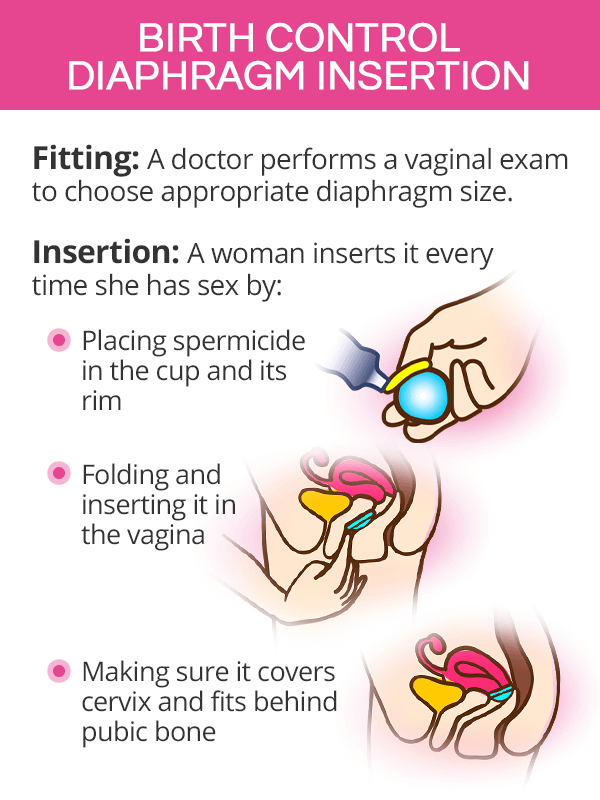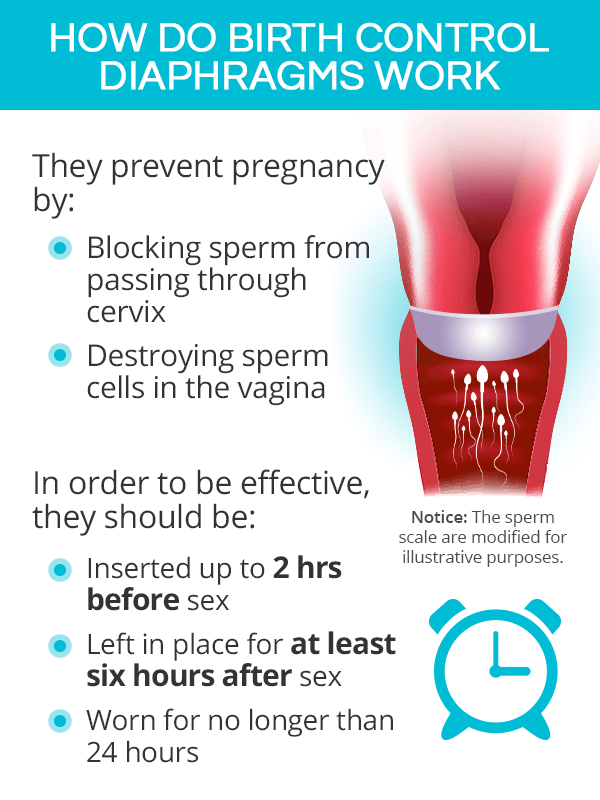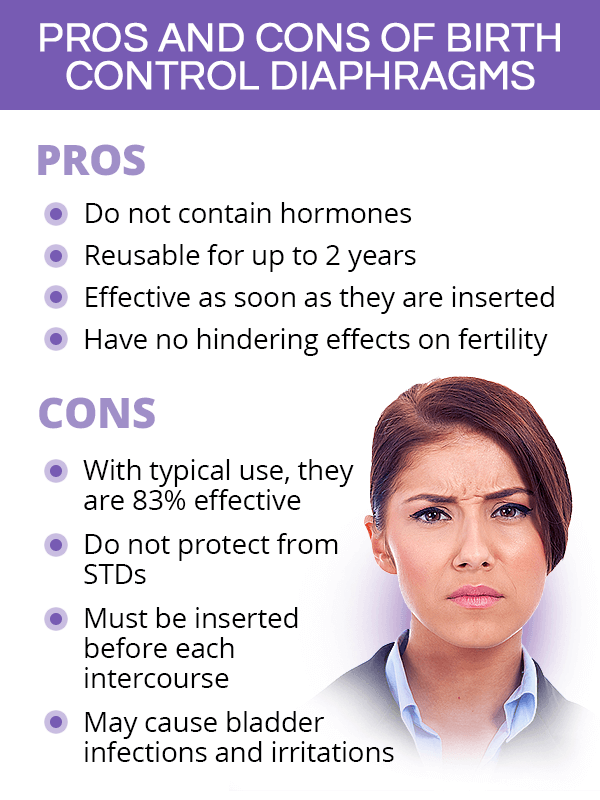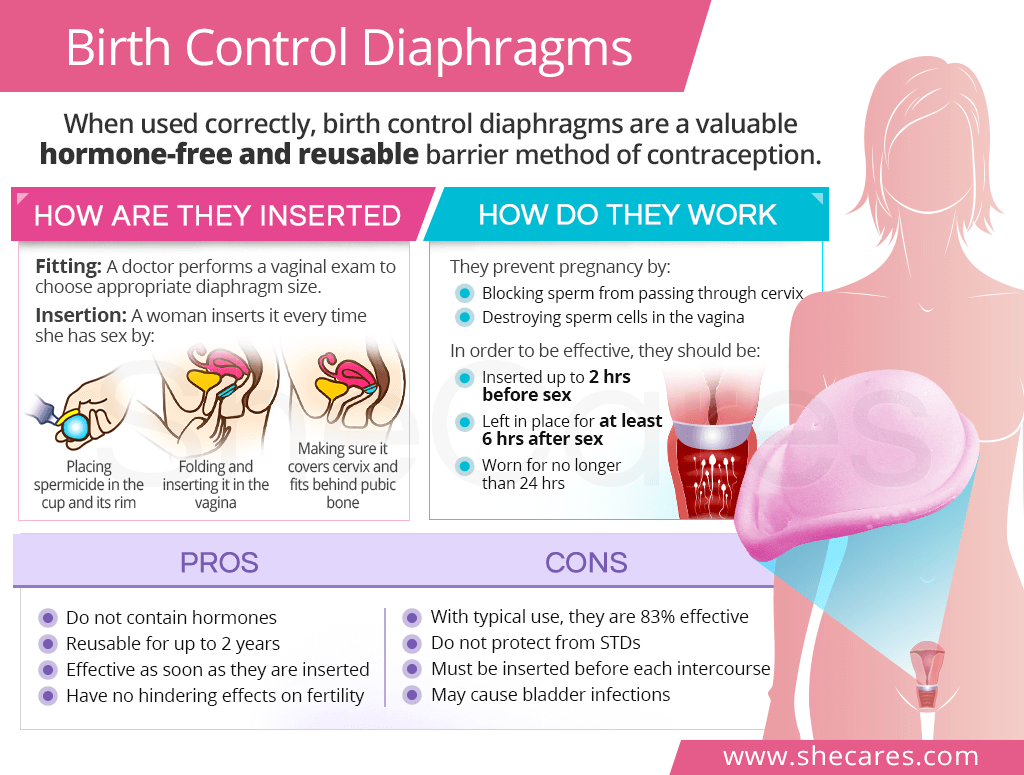What is a Birth Control Diaphragm?
A birth control diaphragm is a type of barrier birth control method. It does not contain reproductive hormones.
It is in the form of a dome-shaped silicone or latex disk that comes in several sizes and are used with spermicide gel. Most commonly, the spermicide gel contains a chemical called nonoxynol-9.1
Diaphragms can be purchased with doctor's prescription. Spermicides, on the other hand, are available over the counter.
Birth Control Diaphragm Insertion
Before a woman can start inserting birth control diaphragms on her own, she first must be properly fitted by a doctor to ensure their safety and effectiveness.
Diaphragm Fitting

To choose the appropriate size of a diaphragm, a doctor will perform a vaginal exam to take proper measurements of a woman's anatomy.
Then, he or she will use a lubricated fitting ring or a diaphragm to insert in the vagina and make sure its anterior rim fits correctly behind the pubic bone, and the posterior rim is positioned deep in the posterior vaginal fornix.
Diaphragm Insertion & Removal
To insert a diaphragm, a woman should carefully examine the disk for accidental holes. Then, she should follow these steps:
- Place a teaspoon of the spermicide gel inside the cup and on its rim.
- Pinch the rim together to fold the diaphragm and insert it deeply in the vagina.
- Make sure the disk covers the cervix, fits behind the pubic bone, and does not feel uncomfortable.
To remove a diaphragm, she should hook her finger over its rim to break the suction and pull it down and out of the vagina.
Proper care in between insertions consists of washing it with soap and water; air drying it, and storing it in a designated container.
How do Birth Control Diaphragms Work

Birth control diaphragms are designed to be inserted every time a woman has vaginal intercourse. As all barrier methods of birth control, they prevent pregnancy through the following actions:
- The disk blocks sperm from entering the cervix.
- The gel destroys sperm cells in the vagina.
Their effectiveness highly depends on whether they are inserted correctly before and removed properly after intercourse. For optimal protection, a woman should use the following recommendations:2
- Insert a diaphragm up to two hours before having sex.
- Leave it in place for at least six hours after having sex.
- Do not leave it it for more than 24 hours to prevent complications, like toxic shock syndrome.1
If a woman has another intercourse during six hours, she should not remove it. Instead, she can apply spermicide in the vagina for added protection. It is key to always read instructions on spermicide products as the specifics may vary slightly.
Pros and Cons of Birth Control Diaphragms

While they are easy to use and offer numerous other benefits, diaphragms come with significant limitations that may weaken their effectiveness.
Pros of Birth Control Diaphragms
- They do not contain synthetic hormones.
- They are a cost-effective option since one diaphragm disk can be re-used for up to two years.2
- Women with latex allergies can use a silicone diaphragm.
- Diaphragms are effective as soon as they are placed in the vagina alongside spermicide gel.
- They do not have any hindering effects on a woman's fertility.
Cons of Birth Control Diaphragms
- Diaphragms are 94% effective with perfect use and 83% effective with typical use.3,4
- They do not give protection from sexually transmitted diseases (STDs).
- Diaphragms must be placed in the vagina before each intercourse.
- They may not be a good option for women with a tendency for bladder infections and vaginal irritations.5
- They are not recommended in the first six weeks after giving birth.2
- The chemical in most spermicide gels has been linked to certain health risks, like a higher risk of HIV and others.5
Key Takeaways
Being hormone-free and reusable, birth control diaphragms are a worthy option for many women of reproductive age. They come in several sizes, are shaped like a dome to cover the cervix, and are filled with spermicide, thus forming a barrier and preventing sperm from entering the uterus. After being properly fitted by a doctor, a woman inserts a diaphragm before each intercourse and wears it for at least six hours after having sex. They can be re-used for up to two years, which is another advantage of diaphragms over other birth control methods. However, one of their disadvantages is that with typical use, they are only 83% effective. They also do not protect against STDs and may cause bladder infections. Nevertheless, they can fit the needs of many women who prefer to stay away from hormonal contraception.
Sources
- CDC. (2020). Contraception. Retrieved September 22, 2020 from https://www.cdc.gov/reproductivehealth/contraception/index.htm
- Cochrane. (n.d.). Cervical cap versus diaphragm for birth control. Retrieved September 22, 2020 from https://www.cochrane.org/CD003551/FERTILREG_cervical-cap-versus-diaphragm-for-birth-control
- Eunice Kennedy Shriver National Institute of Child Health and Human Development. (2017). Contraception. Retrieved September 22, 2020 from https://www.nichd.nih.gov/health/topics/contraception/conditioninfo/types
- Harvard Health Publishing. (n.d.). Diaphragm, Cervical cap, Sponge. Retrieved September 22, 2020 from https://www.health.harvard.edu/birth-control/methods/type/diaphragm-cervical-cap-sponge
- Medline Plus. (2020). Barrier methods of birth control - Diaphragm. Retrieved September 22, 2020 from https://medlineplus.gov/ency/presentations/100107_4.htm
- University of Michigan. (n.d.). Other barrier methods: diaphragms, cervical caps and sponges, plus spermicide. Retrieved September 22, 2020 from https://uhs.umich.edu/contraception-other
Footnotes:
- Mayo Clinic. (2020). Spermicide (Vaginal Route). Retrieved September 22, 2020 from https://www.mayoclinic.org/drugs-supplements/spermicide-vaginal-route/proper-use/drg-20070769
- Better Health Channel. (2019). Contraception - diaphragms. Retrieved September 22, 2020 from https://www.betterhealth.vic.gov.au/health/HealthyLiving/contraception-diaphragms
- CDC. (2020) Diaphragm. Retrieved September 22, 2020 from https://www.mayoclinic.org/tests-procedures/diaphragm/about/pac-20393781
- Planned Parenthood. (2010). What is the difference between a cervical cap and a diaphragm? Retrieved September 22, 2020 from https://www.plannedparenthood.org/learn/teens/ask-experts/what-is-the-difference-between-a-cervical-cap-and-a-diaphragm
- American Family Physician. (2004). Diaphragm Fitting. Retrieved September 22, 2020 from https://www.aafp.org/afp/2004/0101/p97.html
